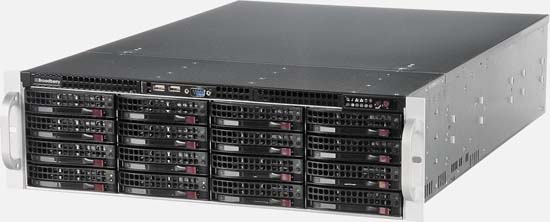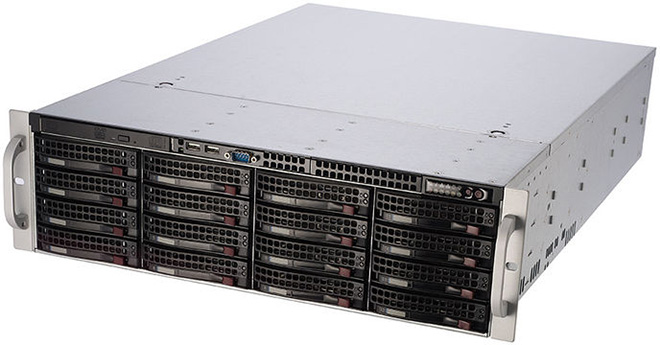Read Product Review CyberStore 316S WSS iSCSI SAN / NAS
The first Windows Storage Server 2012 appliance to market offers good value, great performance and massive expansion potential
Dave Mitchell 20 Feb 2013 |



Configure From $5,547.58 or Configure

The first Windows Storage Server 2012 appliance to market offers good value, great performance and massive expansion potential
Dave Mitchell 20 Feb 2013 |



Configure From $5,547.58 or Configure


It lays down a marker in other ways, too, delivering a base 24TB plus plenty of room to expand, all for less than seven grand. The price above includes six 4TB WD Enterprise SAS drives, and there's room at the front for ten more. They're managed by an LSI SAS 9280 RAID card, which has an external port for Broadberry's JBOD disk shelves, allowing a maximum capacity of 240 disks.
WSS2012 is loaded on a pair of mirrored 256GB SSDs. These are hidden away at the back of the chassis in hot-swap bays beneath dual-redundant power supplies, and are managed by the motherboard's SATA controller.
Unlike the previous version, which didn't offer any major improvements over its predecessor, this one is full of new features. The CyberStore comes with WSS2012 Standard, which has everything enabled. There's block-level deduplication, thin provisioning, NAS and IP SAN support, storage spaces, SMB3 and NFS4.1 support, and much more. It also includes an unlimited capacity licence, doesn't require CALs (client access licenses), and to use the clustering/failover features you just add the necessary hardware.

As with Windows 8, you'll have to get used to the tile-based Start screen and Charms bar, but once you've got past these, most storage features can be configured from the desktop-based Server Manager interface.
Selecting File and Storage Services takes you to menus for configuring disks, volumes, storage spaces, shares and iSCSI targets. Storage pools should be your first port of call, though, since these enable many important features. Physical disks of different sizes and makes can be combined in a pool and used to create mirrored, striped or RAID5 virtual volumes. Capacity can be expanded on the fly by selecting any available drive and adding it to the pool.
Microsoft's thin provisioning works directly with storage pools, so applies to NAS shares and iSCSI targets created within them. When creating a virtual volume, simply decide on the RAID type and then the virtual size, in gigabytes, terabytes or even petabytes.
For share creation, a Quick option does most of the legwork, while an Advanced option lets you set access permissions, choose properties to be used for file classification and data management rules, and apply share-level quotas. The Application option allows shares to be created with settings that suit Hyper-V or databases.
IP SANs are also easy to create: again, just select a virtual volume then decide on a target name and size. The new WSS2012 access controls require initiators to be assigned to the target and you can see any that are already logged in.
Deduplication is applied at the volume level, and options include being able to set the number of days before a file is processed, file exclusions and schedules. To test data reduction ratios we used the Binary Testing deduplication test suite and CA's ARCserve r16 set to use a mapped share as a disk-based backup device. Using a 4GB data set of 1,000 files, we ran a standard backup strategy consisting of daily incremental and full weekly backups. After the first backup had completed, deduplication was run manually, then 2% of data was modified in 40% of files prior to each subsequent backup.
At the end of four weeks' simulation, the reduction ratio hit 7:1. This is close to ARCserve's own score and superior to ZFS-based storage appliances, such as Netgear's ReadyDATA 5200.
The CyberStore 316S WSS shows off Microsoft's Windows Storage Server 2012 perfectly. It brings together a substantial hardware package with room to expand, offers plenty of storage features, and tops it off with strong performance and exceptional data reduction ratios.
Author: Dave Mitchell